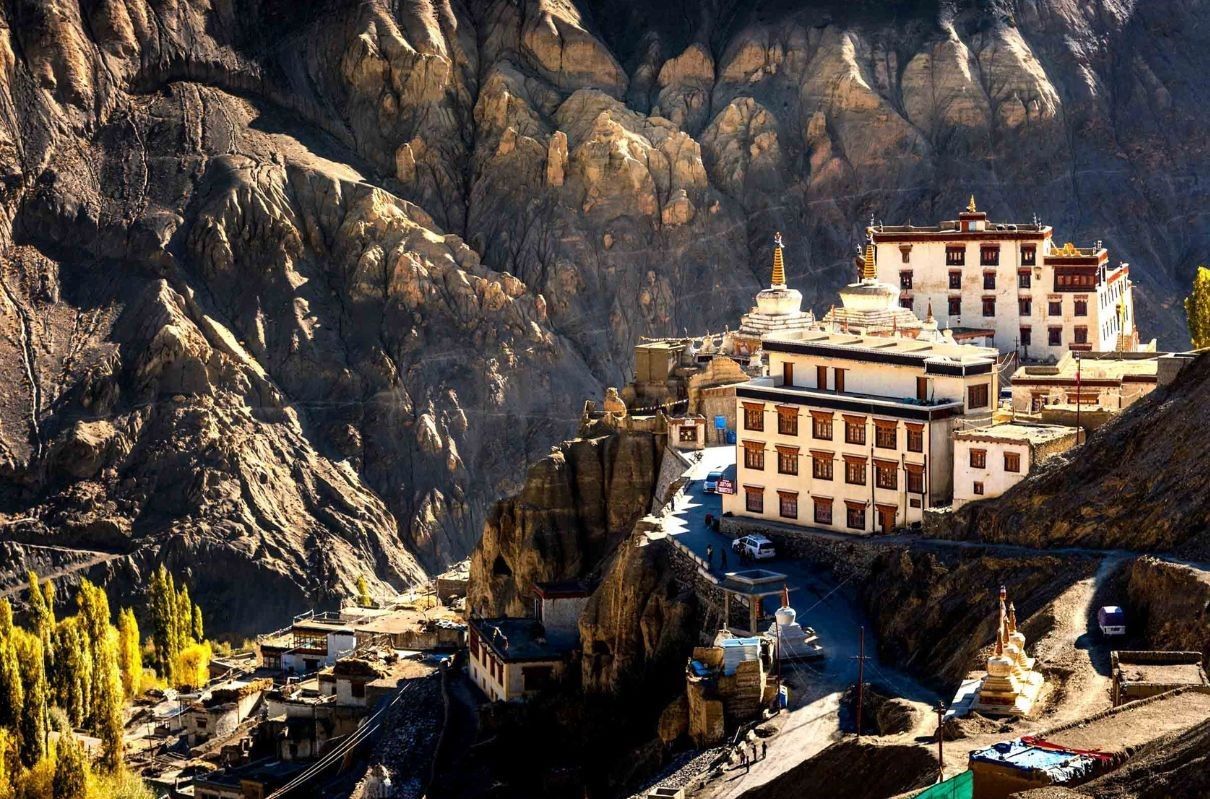
Lamayuru Monastery, often called the "Moonland of Ladakh," is a fascinating destination with a rich history and stunning architecture. Why is Lamayuru Monastery so special? This ancient monastery, perched on a dramatic cliffside, offers breathtaking views of the surrounding landscape. Founded in the 11th century, it stands as one of the oldest and largest monasteries in Ladakh. The monastery is home to a vibrant community of monks who practice Tibetan Buddhism. Visitors can explore its intricate murals, ancient scriptures, and sacred relics. The annual Yuru Kabgyat festival, celebrated with colorful masks and traditional dances, adds to its allure. Whether you're a history buff, spiritual seeker, or adventure enthusiast, Lamayuru Monastery promises an unforgettable experience.
Lamayuru Monastery: A Glimpse into History
Lamayuru Monastery, also known as Yuru Gompa, is one of the oldest and largest monasteries in Ladakh, India. Its rich history and unique architecture make it a fascinating destination for travelers and history enthusiasts alike. Here are some intriguing facts about this ancient monastery.
-
Ancient Origins: Lamayuru Monastery was founded in the 11th century by Mahasiddhacharya Naropa, a renowned Indian Buddhist scholar.
-
Legendary Beginnings: According to legend, the site of the monastery was once a lake. Naropa is said to have dried up the lake to build the monastery.
-
Yuru Kabgyat Festival: The monastery hosts the Yuru Kabgyat festival every year, attracting visitors from all over the world. This festival features traditional mask dances and rituals.
-
Drikung Kagyu School: Lamayuru Monastery belongs to the Drikung Kagyu school of Tibetan Buddhism, one of the eight major schools of Tibetan Buddhism.
-
Moonland: The area around the monastery is often referred to as "Moonland" due to its unique, moon-like landscape.
Architectural Marvels
The architecture of Lamayuru Monastery is a blend of traditional Tibetan and Indian styles. Its structures and artworks are a testament to the craftsmanship of ancient builders.
-
Cave Monastery: Originally, the monastery was built around a series of caves where monks meditated.
-
Main Assembly Hall: The main assembly hall, known as Dukhang, houses numerous statues of Buddha and other deities.
-
Intricate Murals: The walls of the monastery are adorned with intricate murals depicting scenes from Buddhist mythology.
-
Stupas and Chortens: The monastery complex includes several stupas and chortens, which are Buddhist reliquary structures.
-
Wooden Carvings: The monastery features exquisite wooden carvings, particularly on the doors and windows.
Spiritual Significance
Lamayuru Monastery is not just an architectural wonder; it is also a place of deep spiritual significance for Buddhists.
-
Meditation Retreat: The monastery serves as a meditation retreat for monks and laypeople seeking spiritual growth.
-
Sacred Relics: The monastery houses several sacred relics, including ancient manuscripts and religious artifacts.
-
Monastic Community: Lamayuru is home to a vibrant monastic community, with monks of all ages living and studying there.
-
Pilgrimage Site: It is a popular pilgrimage site for Buddhists from around the world.
-
Teachings and Rituals: The monastery regularly conducts teachings and rituals, preserving ancient Buddhist traditions.
Cultural Impact
Lamayuru Monastery has had a significant impact on the culture and traditions of the region.
-
Local Festivals: The monastery's festivals are an integral part of the local culture, bringing together communities in celebration.
-
Art and Craft: The monastery has influenced local art and craft, with many artisans drawing inspiration from its murals and carvings.
-
Cultural Exchange: Over the centuries, the monastery has been a center for cultural exchange between India and Tibet.
-
Traditional Music: Traditional Buddhist music, including chants and instrumental performances, is an important aspect of the monastery's cultural heritage.
-
Educational Role: The monastery plays an educational role, teaching Buddhist philosophy and practices to new generations.
Natural Surroundings
The natural surroundings of Lamayuru Monastery add to its mystique and allure.
-
Scenic Location: The monastery is perched on a hilltop, offering stunning views of the surrounding mountains and valleys.
-
Wildlife: The area around the monastery is home to diverse wildlife, including Himalayan blue sheep and snow leopards.
-
Flora: The region's unique flora includes medicinal plants used in traditional Tibetan medicine.
-
Trekking Destination: Lamayuru is a popular starting point for treks into the Zanskar Valley and other remote areas.
-
Photographer's Paradise: The dramatic landscapes and ancient architecture make it a favorite destination for photographers.
Modern-Day Relevance
Despite its ancient origins, Lamayuru Monastery remains relevant in the modern world.
-
Tourist Attraction: The monastery is a major tourist attraction, drawing visitors from around the globe.
-
Conservation Efforts: Efforts are being made to conserve the monastery's ancient structures and artworks.
-
Cultural Preservation: The monastery plays a crucial role in preserving the cultural heritage of Ladakh.
-
Community Support: The monastery supports the local community through various initiatives, including education and healthcare.
-
Spiritual Tourism: It is a key destination for spiritual tourism, attracting those seeking peace and enlightenment.
Fun Facts
Here are some fun and lesser-known facts about Lamayuru Monastery that you might find interesting.
-
Film Location: The monastery has been featured in several films and documentaries due to its stunning location and architecture.
-
Monk Debates: Monks at Lamayuru engage in lively debates on Buddhist philosophy, a tradition that dates back centuries.
-
Unique Cuisine: The monastery's kitchen serves traditional Ladakhi cuisine, including dishes like thukpa and momos.
-
Library: Lamayuru Monastery has an extensive library with ancient texts and scriptures.
-
Visitor Accommodation: The monastery offers basic accommodation for visitors, allowing them to experience monastic life firsthand.
-
Astronomical Significance: The monastery's location is considered auspicious for astronomical observations, and it has been a site for celestial studies in the past.
The Final Word on Lamayuru Monastery
Lamayuru Monastery, perched high in the Himalayas, is a treasure trove of history and culture. Founded in the 11th century, it's one of the oldest monasteries in Ladakh. The monastery's unique architecture, with its whitewashed walls and prayer flags fluttering in the wind, creates a serene atmosphere. Visitors can explore ancient murals, statues, and the famous cave where Naropa meditated. The annual Yuru Kabgyat festival, featuring masked dances, draws crowds from far and wide. Despite its remote location, Lamayuru remains a beacon of Buddhist spirituality and a testament to the region's rich heritage. Whether you're a history buff, a spiritual seeker, or just someone looking for breathtaking views, Lamayuru Monastery offers something special. So, pack your bags and experience the magic of this ancient sanctuary.
Was this page helpful?
Our commitment to delivering trustworthy and engaging content is at the heart of what we do. Each fact on our site is contributed by real users like you, bringing a wealth of diverse insights and information. To ensure the highest standards of accuracy and reliability, our dedicated editors meticulously review each submission. This process guarantees that the facts we share are not only fascinating but also credible. Trust in our commitment to quality and authenticity as you explore and learn with us.


